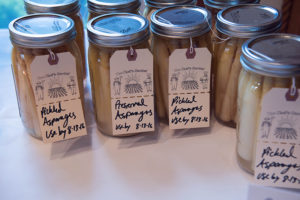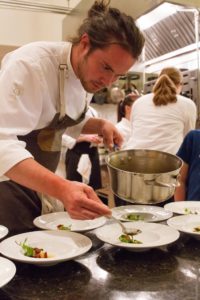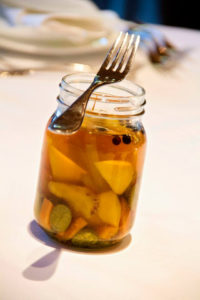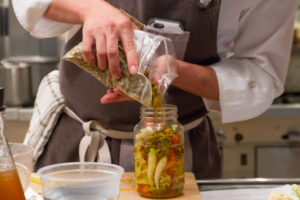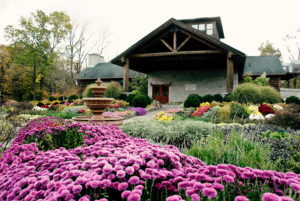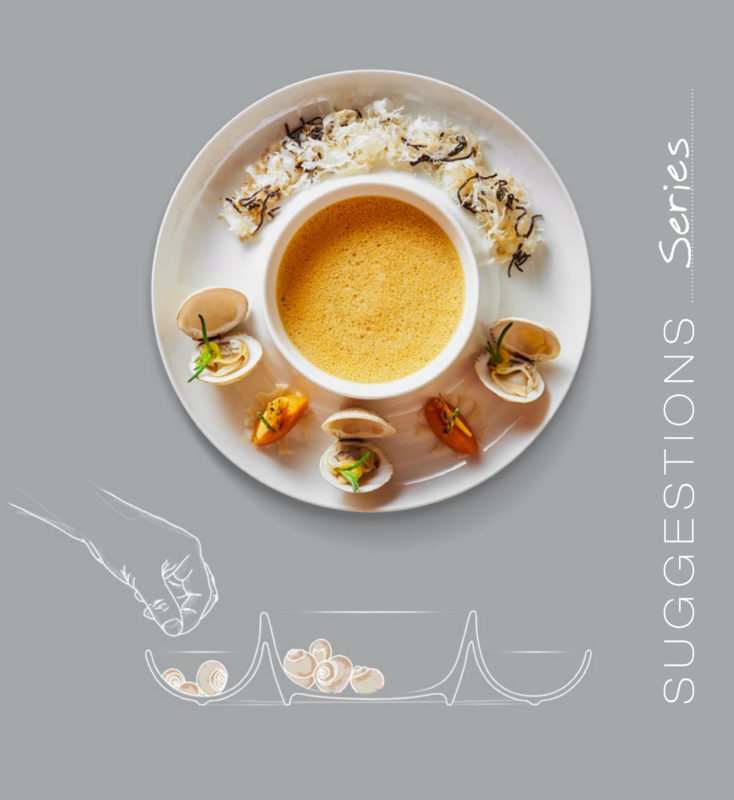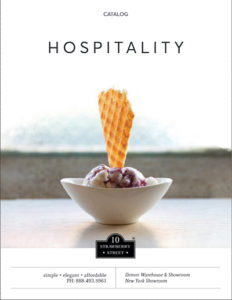At the Culinary Vegetable Institute, Chef Liaison Jamie Simpson, explores all boundaries as he directs one of the most prestigious kitchens in the country. Recently, we had the opportunity to pose a few questions about the role of pickled vegetables in restaurants today.
Here’s What Jamie had to tell us…..
TabletopJournal: We hear the terms pickling and fermentation frequently. For the lay person, what is the difference in these two processes?
Jamie Simpson: Pickling foods in a traditional vinegar based brine prevents the growth of microflora which prevents fermentation; though pickling foods in vinegar absolutely could not exist without a complex fermentation process of producing alcohol and converting that to acetic acid which in layman terms is referred to as vinegar.
TJ: Why do you feel pickled vegetables are trending so strongly and finding their way onto more and more restaurant menus these days?
JS: We’ve seen an incredible increase in interests around vegetables in general. I’m willing to go out on a limb and say that theres more versatility in a carrot than there is in a steak. The costs of most bulk vegetables fall far below the costs of proteins so from an operators perspective, exploring ingredients thoroughly with the highest margins is good business. Pickled vegetables are tapping right back into our roots as a civilization in general through the art and craft of food. If seasonal menu items are of importance to a business, then naturally, preserving ingredients for the following season is the only way you can manage this. Between frozen, canned, lacto fermented, dried, & pickled forms of preservation, Vinegar based pickles are typically always successful and of the lowest risk with local health departments. Also, our fear of fat as a culture in the dining scene is not as bad as it was 10 years ago. Fatty steaks, fatty pork, good butter, and oil are here to stay for a while. Pickled vegetables provide an amazing balance to these ingredients.
TJ: We know that pickled vegetables are growing in popularity with consumers. What are the operational benefits to chefs and restaurant operators in using pickled vegetables?
JS: Often times, the difference between profit and loss in this industry is the weight of our garbage can. Minimizing waste can maximize perception of value and profitability. Pickled stems, leaves, and peels, can contribute right back to the dish from which those waste items came. Managing overage through a solera type batch of giardiniera is a common old world example of this and when done well, it’s stunning. Cauliflower, carrots, artichokes, radishes, turnips, parsnips, peppers, cucumbers green tomatoes, sweet potatoes, garlic, onions and all herb stems can go into one batch and be served and sold as a seasonal item on any menu. For 2016, we averaged a 23% food cost in a venue that sells a different menu every service and were only open on average three days a week to dining guests.
TJ: In our discussion, we spoke about our experiences with pickled vegetables in a number of the restaurants in Portland, Maine. Are the other culinary centers around America where restaurant guests might be surprised at the widespread presence of pickled vegetables on the menu?
JS: The Culinary Vegetable Institute at The Chef’s Garden has its finger on the pulse of this industry. With an average of 600 visiting chefs a year, we are at the heartbeat of trends and issues the industry is shifting to and from. We’re seeing pickled vegetables most widespread throughout the south and southeast. Charleston, Atlanta, Nashville, Memphis, Raleigh, Asheville, Ect.. Beyond Maine where preservation never really left, the Pacific Northwest is huge for pickles. Portland, Seattle, & Vancouver even bleeding down south to San Francisco where Pickles are king in several notable restaurants.
TJ: In terms of dinnerware and tabletop serving pieces, what considerations should chefs and restaurateurs who are looking at using more pickled vegetables be considering when the serve them to their guests?
JS: In a cohesive look and feel between serving pickled vegetables and serving them with connotation, I’d always suggest small Bormioli Rocco Fido swing top clamp jars or large ones to serve from table side. Elements of wood caddies or trays overlap seamlessly with one off antique silverware pieces from the antique store. Long handle pickle forks and asparagus tongs. Elements of Cheese Cloth and patina brass, copper, or silver. The entire craft line of plates from Steelite Internationals performance line is a perfectly suited no brainer. These small five inch coupes, bowls, and plates are screaming for pickled vegetables in my opinion.
TJ: What’s the best way for chefs who are just getting started to learn more about preservation and pickling of vegetables, along with how to incorporate them into their menus?
JS: Chefs who are looking to get started in preservation and pickling vegetables as well as application and incorporation should come visit us at the Culinary Vegetable Institute at The Chef’s Garden. This year, I certified the Culinary Vegetable Institute as a cannery through a course presented by UC Davis. Beyond that, there are many materials available online and through books as well. Sandor Ellix Katz, also known as Sandorkraut, as well as Fermentation God, has volumes of information available to anybody interested in the subject.


